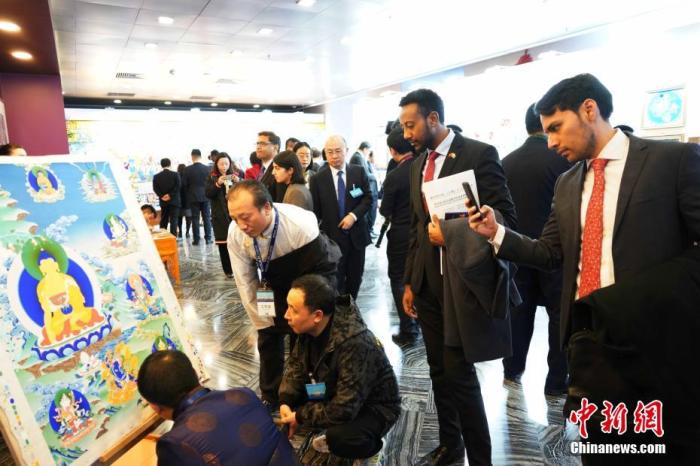Qinghai intangible cultural heritage inheritor: the beauty of art belongs to the world
In the Blue Room of China's Ministry of Foreign Affairs, Lhamo Yezhong, an inheritor of intangible cultural heritage Tibetan embroidery, sat in front of an embroidery frame, the needle thread in her hand shuttling up and down. On the wall behind her was a Tibetan embroidery piece 12 meters long and three meters wide.
On Novemebr 26, the Ministry of Foreign Affairs held a global promotional event for northwest China's Qinghai Province.

Photo shows a handicraft master from Qinghai exhibits thangka painting drawing to guests. [Photo/China News Service]
34-year-old Lhamo Yezhong was born in Guinan County, Hainan Tibetan Autonomous Prefecture, Qinghai Province, an area known as "China's Tibetan Embroidery Production Base" and the "Hometown of Tibetan Embroidery". Nearly all Tibetan women in this area can embroider.
"Tibetan embroidery skills are mainly passed down through familial inheritance. Traditional Tibetan embroidery pieces are mainly made for religious purpose, such as Tibetan embroidery thangka painting, and ethnic clothing and accessories such as Tibetan women's clothing."
In a time of mass production and modern machinery, traditional handicrafts such as Tibetan embroidery are becoming fewer and fewer. In 2006, Lhamo Yezhong and her father led the girls of the village in making Tibetan embroidery.
"I want to help more people in the village join the team of Tibetan embroiders so that more people will know about Tibetan embroidery and enjoy it." Today, Tibetan embroidery works from Guinan County have been exported to the United States, Nepal, India, and other countries.
"Through programs such as the revitalization plan for Chinese traditional handicrafts and the intangible cultural heritage inheritor group study and training program, many intangible cultural heritage items in Qinghai Province have been brought to the lives of modern people and met their needs. Participating in the global promotion event is a rare opportunity. We would like to take this opportunity to show the image of Qinghai to the world and to present Qinghai's folk art to the world," Lu Xia, deputy director of the Qinghai Province Department of Culture and Tourism, said.
Editor: Tommy Tan.
Tibet Stories

70 Years on: Drawing the newest, most beautiful blueprint on Tibetan Plateau
There have been three construction surges in Tibet in the last century.







